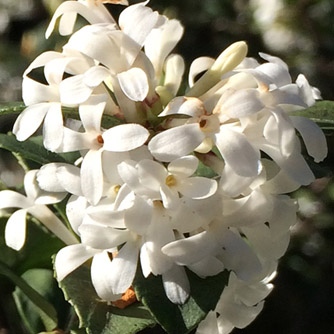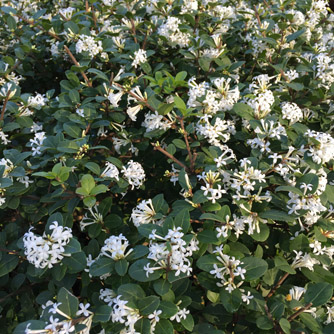Osmanthus
BackOsmanthus are a group of around 30 different shrubs or small trees but the ones we’re most interested in are Osmanthus fragrans and Osmanthus delavayi. Why? Because they’re hardy evergreen plants which produce heavenly perfumed flowers. Gotta love that!
- Osmanthus fragrans – grows to around 3-4m and produces creamy white flowers that smell something like peaches, apricots, gardenias or jasmine – depending on who’s nose you ask
Flowering time can vary from region to region but most commonly occurs during winter and spring. It can be slow growing but makes a great tall hedge. Flowers are traditionally used to scent tea.
- Osmanthus delavayi – best known as the popular varieties ‘Pearly Gates’ and ‘Heaven Scent’ that grow to about 1.5m – 2m high. Clusters of white flowers are equally perfumed and appear in winter and spring. Well suited to pots and garden beds they also make a perfumed alternative to a buxus hedge.
Both are drought tolerant once established and frost hardy.
How To Grow Osmanthus
Osmanthus are versatile, hardy plants that will grow well in most parts of Australia except the tropics.They happily grow in full sun to shady locations but in regions with hot dry summers they’ll benefit from protection from scorching afternoon sun.

Osmanthus delavayi flowers
Their preference is for rich fertile soil but will tolerate just about any soil type as long as it drains well. So if your soil is clay based, it’s a good idea to apply gypsum before planting. If your soil is on the poor side then mix some manure and compost in before planting.
After planting water in well with OCP eco-seaweed to minimise transplant shock and then mulch to keep weeds at bay and retain moisture.
Maintenance of Osmanthus
Established plants are pretty much low fuss when it comes to maintenance. In spring and autumn they’ll appreciate a layer of compost or manure around their base and a dose of gypsum (if in heavy soils). To maximise growth in younger plants OCP eco-seaweed and OCP eco- aminogro should be applied every 2-4 weeks. Potted plants will also benefit from this regular liquid feeding.
After flowering prune lightly to maintain shape if necessary.
If you want to propagate new plants this can be done using softwood or semi hardwood cuttings taken in spring.
Pests and Diseases of Osmanthus
Osmanthus are relatively free from pest and diseases. Plants grown in shady positions may succumb to scale and sooty mould but a few sprays of a horticultural oil will quickly get this under control. Spray both sides of the leaf to run off.
Caterpillars have been known to have a chomp on leaves from time to time. Spray with OCP eco-neem if this becomes a problem.

Osmanthus 'Pearly Gates' in full flower


